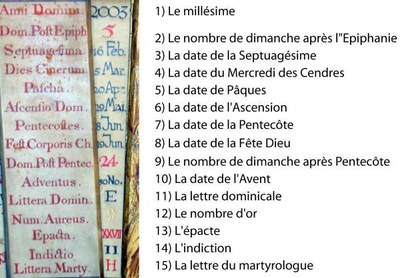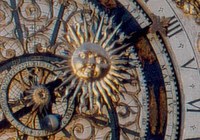II-Description of the astronomical clock
III-Automata and chiming mechanisms
General
Inscriptions
The astrolabe
The hour hand, or « alidade », guides the sun on the ecliptic circle ; it performs one revolution in 24 hours. The rete revolves in the same direction as the alidade but indicates sidereal time ; it performs one revolution in 23 hours 56 minutes. As a result, one full revolution of the alidade corresponds to one full revolution of the rete plus 4 minutes or 1/365 addition al revolution which is one division on the rete or one day in the year.
The Computus Ecclesiasticus and the perpetual calendar
 |
 |
| The calendar and the computus in the center | The computus for year 2003 |
These are located under the astrolabe. The Computus in the centre is established for 66 years and was extended by Ch. Morat for the years 2020 to 2085. It is surrounded by the circle of the calendar. On the right you can see the 15 indications of the Computus : the year, the number of Sundays after Epiphany, the dates of Septuagesima, of Ash-Wednesday, of Eastern, of Ascension Day, of Whitsunday, Corpus Christi and several other holydays.
 |
 |
| Mechanism of the calendar | Indications of the calendar |
Figure on the left illustrates the mechanism of the yearly drop: at each revolution of wheel V292 (making a full revolution per year), the pin sigma on one of its arms lifts the lever beta. As a result, lever beta pushes a pin on the ratchet-wheel rho forcing it to rotate 1/6 of a turn. The wheel affixed on rho has 24 teeth ; it acts on wheel U264 having 264 teeth. The ratio Q/P being 1/11, each revolution of wheel V292 enduces the rotation of wheel U264, which carries the Computus, by 1/66 turn.
Photo on the right shows the six indications given by the calendar : the month (Augustus), the lunar calendar (in 2003 the new moon was on the 6th), the Dominical Letter (E for 2003), the Roman calendar (VIIth day before the Calends of February), the date (26), the Saint of the day (Saint-Polycarpe). The most interesting indication is that of the Dominical Letter given each year by the Computus (the first seven days of the week being designated by the seven first letter of the alphabet). In 2003 the Dominical letter is E, which will correspond to all Sundays of the year. Augustus 8 (E) is a Sunday, Augustus 9 (D) a Monday, ... Augustus 13 (A) a Friday ... etc.
The going train
 |
 |
| Drawing of the main train | Dial of minutes |
The drawing on the right shows the main train of the clock. The pendulum is 2m715 long; its period is 3.3 seconds. Hour keeping is remarkable for a mechanism designed in the XVIIIth century : deviations do not exceed one minute per month.
 |
The drawing on the left represents the working mechanism of the retractable minute hand on the oval dial. The hand is fixed on pinion B. The rod C is attached to pinion A which rotates in the opposite direction. The two ends of the hand D and D', locked to the rod C via arms F and G, follow an elliptic path.
Document Actions






